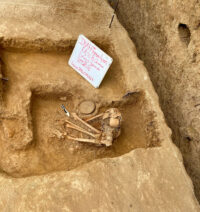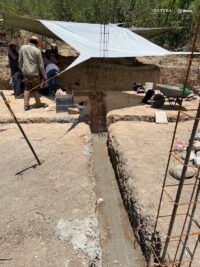 The skeletal remains of a man buried at least 1,300 years ago have been discovered in the northeastern state of Tamaulipas, Mexico. It is one of the first known intact pre-Hispanic graves in the region found outside of a cave.
The skeletal remains of a man buried at least 1,300 years ago have been discovered in the northeastern state of Tamaulipas, Mexico. It is one of the first known intact pre-Hispanic graves in the region found outside of a cave.
The remains were discovered on July 8th during construction of a raised water tank for the community of San Lorenzo de las Bayas. Located in the Sierra Madre Oriental mountains, remote San Lorenzo is connected to the nearest city, Ocampo, by a 25-mile dirt road. Significant archaeological sites, including ancient open-air settlements and cave art, have been found there thanks solely to the reports from local residents who are very conscious of their cultural patrimony. This is the first known intact burial found in the area. The workers promptly notified the National Institute of Anthropology and History (INAH) of the find and two days later archaeologists were on site. The team excavated the grave and also supervised the ongoing construction of the reservoir.
 The remains were found to be of an adult male between 21 and 35 years old at time of death. He was buried in a seated position with his knees bent. His body had been wrapped in a petate, a bedroll made from palm fibers, which has now disintegrated, but it preserved his bones in their original burial posture. Buried with him was a tripod molcajete, a ceramic mortar with three support legs typical of the Classic Period, ca. 400-700 A.D. It is by the side of the skeleton now, but was probably originally on top of the grave.
The remains were found to be of an adult male between 21 and 35 years old at time of death. He was buried in a seated position with his knees bent. His body had been wrapped in a petate, a bedroll made from palm fibers, which has now disintegrated, but it preserved his bones in their original burial posture. Buried with him was a tripod molcajete, a ceramic mortar with three support legs typical of the Classic Period, ca. 400-700 A.D. It is by the side of the skeleton now, but was probably originally on top of the grave.
The remains were recovered and transported to the osteological laboratory of the Centro INAH Tamaulipas where they will be cleaned, conserved and studied to narrow down his age, determine if he had any illnesses, his possible cause of death and whether his skull show signs of deliberate cranial deformation. Archaeologists spotted signs of at least two more burials at the site, so INAH plans to explore it further in future digs.